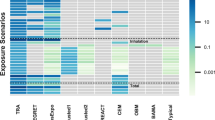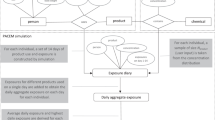Abstract
This paper analyzes the way risk management measures (RMMs) for consumer products have been used to date in authority and industry risk assessments. A working concept for consumer product RMMs is developed, aimed at controlling, limiting or avoiding exposures, and helping to insure the safe use (or handling) of a substance as part of a consumer product. Particular focus is placed on new requirements introduced by REACH (registration, evaluation, and authorization of chemicals). A RMMs categorization approach is also developed, dividing consumer product RMMs into those that are product integrated and those that are communicated to consumers. For each of these categories, RMMs for normal use, accidental use or misuse need to be distinguished. The level of detail for documenting, assessing and communicating RMMs across supply chains can vary, depending on the type of the assessment (tiered approach). Information on RMMs was collected from published sources to demonstrate that a taxonomical approach using standard descriptors for RMMs libraries is needed for effective information exchange across supply chains.
This is a preview of subscription content, access via your institution
Access options
Subscribe to this journal
Receive 6 print issues and online access
$259.00 per year
only $43.17 per issue
Buy this article
- Purchase on Springer Link
- Instant access to full article PDF
Prices may be subject to local taxes which are calculated during checkout



Similar content being viewed by others
References
Beck L.W., Maki A.W., Artman N.R., and Wilson E.R. Outline and criteria for evaluating the safety of new chemicals. Regul Toxicol Pharmacol 1981: 1: 19–58.
Berning C.K., Griffith J.K., and Wild J.E. Research on the effectiveness of denatonium benzoate as a detergent to liquid detergent ingestion by children. Fundam Appl Toxicol 1982: 2(1): 44–48.
De Groot A.C. Fatal attractiveness: the shady side of cosmetics. Clin Dermatol 1998: 16: 167–179.
Directive 2001/95/EC of the European Parliament and of the Council of 3 December 2001 on general product safety, 2001.
Eurobarometer 60.0 (2003), 60.2 (2003), 60.3 (2004), Public Opinion in the European Union, European Comission's Directorate General Press and Communication.
European Chemicals Bureau. 2005 Technical guidance document on preparing the chemical safety report under REACH. REACH Implementation Project 3.2. Report prepared by CEFIC, RIVM, the Federal Institute for Risk Assessment (BfR), Federal Institute for Occupational Safety and Health (BAuA), Ökopol, DHI Water & Environment and TNO Chemistry. European Commission, Joint Research Center, Ispra, Italy ( http://ecb.jrc.it/REACH/.
European Chemicals Bureau (ECB) European Union Risk Assessment Report on 4,4'-isopropylidenephenol (Bisphenol-A), European Commission, Luxembourg, Office for Official Publications of the European Communities, Vol. 37. Report prepared by UK Health & Safety Executive and UK Environment Agency, 2003.
Hendricks M.H. Measurement of enzyme laundry product dust levels and characteristics in consumer use. J Am Oil Chem Soc 1970: 47(6): 207–211.
Jackson M.H., and Payne H.A. Bittering agents: their potential application in reducing ingestions of engine coolants and windshield wash. Vet Hum Toxicol 1995: 37(4): 323–326.
Kovacs D.C., Small M.J., Davidson C.I., and Fischhoff B. Behavior factors affecting exposure potential for household cleaning products. J Expo Anal Environ Epidemiol 1997: 7(4): 505–520.
Nohynek G.J., Fautz R., Benech-Keiffer F., and Toutain H. Toxicity and human health risk of hair dyes. Food Chem Toxicol 2004: 42: 517–543.
Petersen D.W. Profile of accidental ingestion calls received via a toll-free line on detergent product labels. Vet Hum Toxicol 1989a: 31: 125–127.
Petersen D.W. Lemon aesthetics in hand dishwashing detergents do not influence reported accidental ingestion frequency and volume. Vet Hum Toxicol 1989b: 31: 257–258.
PRODUCE. Piloting REACH on downstream use and communication in Europe, 2006 final report. Facilitator Solbé J.F. January 2006.
Regulation (EC) No 1907/2006. Regulation (EC) No 1907/2006 of the European Parliament and of the Council of 18 December 2006 concerning the Registration, Evaluation, Authorisation and Restriction of Chemicals (REACH), establishing a European Chemicals Agency, amending Directive 1999/45/EC and repealing Council Regulation (EEC) No 793/93 and Commission Regulation (EC) No 1488/94 as well as Council Directive 76/769/EEC and Commission Directives 91/155/EEC, 93/67/EEC, 93/105/EC and 2000/21/EC. Official J Eur Union 2006 L 396.
Riley D.M., Fischhoff B., Small M.J., and Fischbeck P. Evaluating the effectiveness off risk-reduction strategies for consumer chemical products. Risk Anal 2001: 21(2): 357–369.
RIP 3.2-2-IV WP 2 Task Group 2. Risk Management Measures, 2007. Briefing note on document RIP 3.2-2 SEG 2 05, 30 January 2007.
Saylor J.H. Volume of a swallow: role of orifice size and viscosity. Vet Hum Toxicol 1987: 29(1): 79–83.
Sibert J.R., and Frude N. Bittering agents in the prevention of accidental poisoning: children's reactions to denatonium benzoate (Bitrex). Arch Emerg Med 1991: 8(1): 1–7.
Soap and Detergent Association. Risk Assessment Guidance for Enzyme-Containing Products 2005: http://www.cleaning101.com/files/SDA_Enzyme_Risk_Guidance_October_2005.pdf.
Technical Guidance Document (TGD). Technical Guidance Document (TGD) on Risk Assessment of Chemical Substances following European Regulations and Directives, 2nd edn European Chemicals Bureau (ECB), JRC-Ispra (VA), Italy, 2003 ( http://ecb.jrc.it/tgdoc).
van Leeuwen C.J., and Hermens J.L.M., (eds.) Risk Assessment of Chemicals: An Introduction. Kluwer Academic Publishers Dordrecht/Boston/London, 1995, ISBN 0-7923-3740-9.
van Leeuwen C.J., and Vermeire T., (eds.) Risk assessment of chemicals: An introduction, 2nd edn. Springer Publishers, Dordrecht, The Netherlands, 2007 (submitted).
Yamashita M., and Tanaka J. Pulmonary collapse and pneumonia due to inhalation of a waterproofing aerosol in female CD-1 mice. Clinic Toxicol 1995: 33(6): 631–637.
Yamashita M., Tanaka J., Yamashita M., Hirai H., Suzuki M., and Kajigaya H. Mist particle diameters are related to the toxicity of waterproofing sprays: comparison between toxic and non-toxic products. Vet Hum Toxicol 1997a: 39(2): 71–74.
Yamashita M., Yamashita M., Tanaka J., Hirai H., Suzuki M., and Kajigaya H. Toxicity of waterproofing spray is influenced by the mist particle size. Vet Hum Toxicol 1997b: 39(6): 332–334.
Acknowledgements
We gratefully acknowledge fruitful discussions and contributions received by Dr Panagiotis Daskaleros (DG Sanco, Brussels) and Dr Kimmo Louekari (DG Enterprise, REACH team Ispra), European Commission.
Author information
Authors and Affiliations
Corresponding author
Rights and permissions
About this article
Cite this article
Bruinen De Bruin, Y., Hakkinen, P., Lahaniatis, M. et al. Risk management measures for chemicals in consumer products: documentation, assessment, and communication across the supply chain. J Expo Sci Environ Epidemiol 17 (Suppl 1), S55–S66 (2007). https://doi.org/10.1038/sj.jes.7500587
Received:
Accepted:
Published:
Issue Date:
DOI: https://doi.org/10.1038/sj.jes.7500587
Keywords
This article is cited by
-
Enhancing the use of exposure science across EU chemical policies as part of the European Exposure Science Strategy 2020–2030
Journal of Exposure Science & Environmental Epidemiology (2022)
-
Consumer exposure and risk assessment to selected chemicals of mold stain remover use in Korea
Journal of Exposure Science & Environmental Epidemiology (2020)
-
Interactions between tetrahydroisoindoline-1,3-dione derivatives and human serum albumin via multiple spectroscopy techniques
Environmental Science and Pollution Research (2018)



